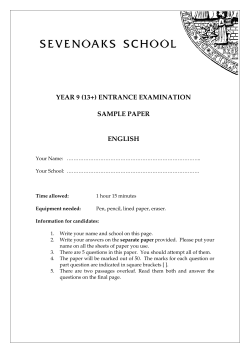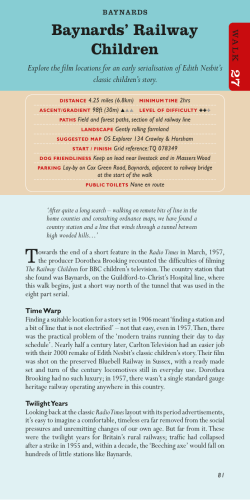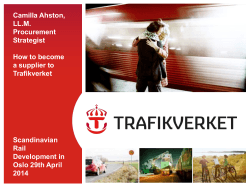
IT INITIATIVES ON INDIAN RAILWAYS THE ROAD AHEAD
IT INITIATIVES ON INDIAN RAILWAYS THE ROAD AHEAD INDIAN RAILWAYS – A SUNRISE INDUSTRY Railways in India, a sunrise industry! Indian Railways, a super ‘ Navaratna’. The Indian Railways (IR) is a truly great institution. It is a global giant that operates profitably, effectively and with relatively little government support. MCKINSEY & COMPANY TODAY’S BUSINESS CHALLENGES Increased operational efficiency Improve productivity from existing systems Streamline and optimize business procedures Responsiveness to constituents Create end-to-end visibility into the business Make the information accessible and actionable Adaptability to change Re-act quickly to threats and opportunities Turn IT into a competitive business asset Current Issues Higher demand for Freight and Passenger transport, with planned economic growth Need for capacity enhancement in the Railway network over the next 10-15 years Technological uprgadation for better maintenance of railway assets Greater competition from Roadways, with major investments in Highway network upgradation Increase freight market share through higher availability of services at competitive prices Greater attention to passenger services and safety Heavily subsidised passenger fares, distorted passenger pricing Upgradation of the Railway Production units for improved efficiency and productivity USING INFORMATION TECHNOLOGY FOR GREATER EFFICIENCY A large complex Infrastructure System such as the Indian Railways can benefit greatly from the intelligent use of IT Objectives Freight revenue enhancement Passenger revenue enhancement Improved and optimised service Agency for implementation of IT EDP Centers CRIS Zonal MIS Groups LRDSS Group Under Planning Cell EARLY STEPS Data processing centers from 60,s Legacy Applications Pay roll Inventory management Operating statistics Applications evolved but functionalities remained the same Attempts to create HRM MMIS Office Applications Applications not system wide Multiplicity of vendors Problems in upgrading systems CRIS - INTERNAL SERVICE PROVIDER FOR IT ON IR DESIGN, DEVELOPMENT AND IMPLEMENTATION OF COMPUTER BASED INFORMATION SYSTEMS AND ASSOCIATED COMMUNICATION NETWORKS AND PRODUCTS AND OTHER SYSTEMS TECHNICAL SUPPORT AND SERVICES TO DEVELOP, SET UP, OPERATE AND MAINTAIN ANY COMPUTERISED SYSTEM AND THE UNDERLYING INFRASTRUCTURE PASSENGER BUSINESS OF IR PASSENGERS CARRIED (IN MILLIONS) 6000 5000 4600 4000 3600 3000 2500 2000 1000 5100 1300 1600 Indian railways have a share of nearly 22% in the passenger transport market DURING 2003-04 5210 Million passengers were carried Passenger kilometers was 530 billion Passenger earning was 13460 crores 0 50S 60S 70S 80S 90S 2000S PASSENGERS KILOMETERS 600 (IN BILLIONS) 520 500 400 300 200 100 300 210 70 80 120 0 50S 60S 70S 80S 90S 2000S Passenger business accounts for 31% of the revenue Passenger business has two major segments Premium passenger service Mass Volume transportation segment PREMIUM PASSENGER SERVICE OFFERED THROUGH MAIL/EXPRESS, SUPER FAST, RAJDHANI AND SHATABDI TRAINS ABOUT 1520 TRAINS ARE RUN DAILY. VARIETY OF SERVICES AC FIRST CLASS AC SLEEPER FIRST CLASS AC 3 TIER AC CHAIR CAR SLEEPER CLASS ORDINARY CHAIR CAR JOURENY THROUGH RESERVATION ONLY PREMIUM PASSENGER SERVICE PRIMIER PASSENGER SERVICE 2003-04 TOTAL PASSENGER PRIMIER TRAFFIC PASSENGERS PASSENGERS (millions) PKM(billions) EARNINGS (crores) 5210.7 234.1 529.6 174.8 13460 7105.6 This segment accounts for 5% of the passenger carried 34% of the PKM 53% of the passenger revenue The average distance covered by each passenger is 760 kms Revenue earned Per PKM is 40 paise Per passenger is RS310 PASSENGER RESERVATION SYSTEM PRS networking of entire Indian Railways completed in April, 1999. PRS is running currently at 1,200 locations, Deploying 4,000 terminals , covering journeys of 3,000 trains and executing ONE MILLION passenger transactions per day. Internet booking of tickets was started In August 2002. TATKAL has been converted from a separate coach to a normal Quota and enabled for all trains in 2004 Internet booking timings extended to 4:00 a.m. – 11:30 p.m. from March 2005. CONCERT (Country Wide Network of Computerised Enhanced Reservation and Ticketing ) 1 64 KBPS Leased Line6 CRIS Mum bai PRS64 KBPS Leased Line 1 2MBPS Leased line 2 MBPS (x2) Leased Line 64 KBPS (x2) Leased Line 64 KBPS Leased Line 1 2MBPS Leased line Chenn ai PRS Delhi 1 64 KBPS PRS Leased Line6 1 2MBPS Leased line Secunder abad 64PRS KBPS (X 2) Leased Line kolka ta PRS Integrates five Regional Reservation Centres Judicious mix local autonomy with uniformity of business rules. Very complex Business transactions. Comprehensive functionality CONCERT Performance Less than 1 sec for local transaction 3 sec for network transaction. Capable for providing reservations for 22 hours per day. Uptime of PRS is 99.5+% CONCERT - COMPLEXITIES 44 types of quotas 8 types of trains 9 types of classes 162 types of concessions 127 types of bogies PASSENGER RESERVATION SYSTEM LOAD PRS NODE Trains Locations Terminals PEAK NO OF AVERAGE NO OF PASSENGERS PASSENGERS PER DAY (IN PER DAY (IN LAKHS) LAKHS) 2001 2004 2001 2004 2001 2004 2001 2004 2001 2004 Delhi 781 1020 153 362 886 1360 2.31 2.75 1.83 2.52 Mumbai 532 686 100 228 640 984 2.01 3.14 1.41 2.42 Calcutta 365 630 102 368 425 1009 1.22 1.81 1.01 1.7 Chennai 271 370 76 183 310 628 1.35 1.65 1.1 1.46 Secunderbad 279 292 59 100 250 492 0.56 0.81 0.4 0.72 Total 2228 2998 490 1241 2511 4473 7.45 10.17 5.75 8.82 PRS – Enquiry Systems Indian Railway’s web-site, www.indianrail.gov.in offers PRS enquiries on the internet Berth/Seat availability, Passenger Status, Fare, Train Schedule etc A maximum of 42 lacs hits per day have been recorded National Train Enquiry System (NTES) website, www.trainenquiry.com gives dynamic information about the running status of any train and its expected arrival/departure at any given station Mobile telephone based SMS enquiry service A new mobile phone based facility for rail users’ viz., Train Delay Alert Service Country wide extension of Universal Rail Enquiry number “139” through setting up of Interactive Voice Response System (IVRS) based state-of-the-art Call Centres Request For Proposal (RFP) is being prepared. PRS – WORKS IN PROGRESS Display of Coach-wise Berth/Seat Vacancy Status Reduction in Waiting List Numbers by utilizing vacant journey-legs of berths E – Ticketing Scheme of Frequent Rail Travellers (SOFT) Hand-held Terminals for TTEs Fund allocated for this work is inadequate Web based Ticket auction Disaster backed PRS sites for business continuity. Migration to RDBMS Architecture. PRS – Data Warehouse Reports giving passengers travelled and earnings realized train-wise for each class vis-à-vis the potential for a selected period have been made available at the five PRS sites. PRS Data Warehousing Reports are now web enabled and are available all over Indian Railways on the website Enhancements to enable Railway users to generate ad hoc reports themselves by using Business Intelligence (BI) Tools planned for the current year. Fund allocation for this work is inadequate MASS VOLUME TRANSPORTATION Consists of the following Suburban traffic Ordinary passenger service Unreserved short distance travel This sector accounts for 95% of the passenger carried 66% of the PKM 47% of the passenger revenue Passengers of this category travel on an average 71 kms for every journey Earning per pkm is 18 paise and per passenger is Rs 13 Unreserved Ticketing System (UTS) The work load involved in printing , accounting and issuing tickets to this mega segment has been a difficult task Printed card tickets have been in vogue since the beginning. Railways had also introduced electro-mechanical printing devices and also SPTM machines. But these methods had limitations Indian railways introduced UTS to improve customer satisfaction, revenue generation, accounting, and reporting capabilities and reduce fraud Unreserved Ticketing System (UTS) A pilot project was inaugurated in Delhi area in August 2002. Since then UTS has been extended to 51 important stations of Northern Railway. UTS server clusters installed in three more Zonal Railways viz., East Central Railway at Patna, North Eastern Railway at Gorakhpur and Eastern Railway at Kolkata. . UTS has also been extended to all the remaining Zonal Railways by connecting certain selected stations of each zones to the existing server clusters of Northern and Eastern Railways. Five more UTS server clusters will be installed in South Eastern Railway, South Central Railway, Southern Railway, Central Railway and Western Railway during MAY – JUNE 2005 Works in progress in UTS UTS is planned to be implemented at 500 more stations during this year Thin Client based UTS successfully implemented on East Central Railway in March 2005. It is planned to gradually extend thin client based UTS to other locations so that ticketing activity can continue even if the communication link or the server goes down for some time. Business Continuity for UTS under all circumstances the most important objective . inter-cluster UTS operation migration plannedto ensure continuous ticketing under all circumstances. FREIGHT TRANSPORT BUSINESS Freight Transport accounts for nearly 70% of IR’s revenue. Railways meet approximately 45%of the national transportation. In the financial year 2003-04, the Railways have moved 557.39 million tonnes of originating revenue earning traffic, against the target of 550 million tonnes and 38.65 million tonnes higher than the previous year’s loading. . Freight Operations Information System An on line real time system for management and control of freight traffic FOIS User driven design and implementation Foundations for a total logistics system Rake Management System (RMS) RMS captures the following events in real time • Customer indents • Wagon supply - date and time • Departure after loading • Running particulars - arrival/departure at stations enroute with attachments or detachments if any • Arrival at destination • Handling and delivery at destination Terminal Management System (TMS) TMS computerises the following: Calculation of freight and other charges Generation of Railway Receipt(RR) Billing and Accountal of freight earnings FOIS Network – An outline Based on a hierarchical tree topology Heterogeneous Communication Media. Railway owned OFC Railway owned digital microwave Leased channels from BSNL. ISDN VSAT based satellite links. Works On Hand in FOIS Control Office Applications = TVC, MDU, WAT, KUR AND KGP AND Entire network of TVC – HWH Section before the end of this year Networked Crew management system for Central and western Railway MIS – Data Warehousing and Data Mining – Initially for one zone and one division planned Payment gateway for more major customers Web enabling of FOIS Revenue Accounting System RFID – immediate need for Pilot Project Coaching Operation Information System COIS Phase I - Punctuality Module implemented with Information Feeding Terminals provided in all Divisional controls, Zonal headquarters and in Railway Board. Punctuality reports for Divisions, Zonal Railways and Railway Board COIS Phase II - Coach Management System (CMS) under testing PHASE III –TIME TABLING Web enabled Claims Implementation completed at all 16 Zonal Railways in Feb 2005. The website has also been opened for general public from Feb 2005 Computerization of Railway Claims Tribunals, Goods-Refund & Subsidiary Claims Offices have been approved for development and implementation in the year 2005 The estimates for the above mentioned projects had been submitted to the Railway Board Design work is in progress for these projects Parcel Management System Following Functions are covered Parcel Booking, Cancellation and Loading monitoring and tracking of Parcels Demurrage and Wharfage Calculation Printing of Parcel labels Networking of all parcel offices RFID tags for tracing parcels INDIAN RAILWAYS CAPITAL AT CHARGE (Rs in crores) 40709 Route kilometers 63122 NUMBER OF STATIONS 6906 NUMBER OF STAFF (In thousands) 1472 Gross Traffic Receipts Total Working Expenses Net Revenue RUPEES IN CRORES 42605 39327 4148 INDIAN RAILWAYS ASSETS PROFILE Total Track Kilometers 109,221 Electrified Track kilometers 39,358 No Of Bridges No Of Level Crossings 119,984 37,423 No Of Passenger Coaches 34,895 No Of Emu/Dmu coaches 4,957 Other Coaching Vehicles 4,904 Total Wagons On Line 214,760 No Of Diesel Locomotives 4,699 No Of Electric Locomotives 2930 MIS Project Overview MIS Project started with three pilot railways viz. NR, SR & CR The development of functional modules entrusted to railways are as under: Civil-CR & NR, Elec. – CR & NR, Mech.-SR, S&T-SR, Security-NR, Vigilance-WR Objective to provide MIS for each department Railway Board decision to transfer the existing contract management to CRIS from pilot railways to implement MIS applications on centralised Architecture awaited Workshop Computerisation Project to be completed in 2 phases. 1st Phase includes 16 workshops on which the work is under progress. To be completed by the end of this year In phase – 2, 15 more workshops will be considered for implementation. Estimate sanctioned. Three major modules Rolling Stock Management (RMS) Production Planning and Control (PPC) Machine & Plant (M&P). Training of staff and procurement of hardware is in progress. Health Management Information System (HIMS) A centralized solution for implementation of HMIS across all the hospitals and health units of IR A prototype for some of the basic modules of HMIS developed and given for testing to Vadodara division A proposal for development and deployment of HMIS as pilot project on western railway is submitted to railway board and approval awaited Rail Budget Compilation System (RBCS) . A web-enabled works programme management system is being developed and linked to same Comprehensive Accounting & Transaction System (CATS) for RDSO Comprehensive Pay Roll Processing System (CPPS) for DLW Railway Officers Information System (ROIS) Data Center for Zonal railways MIS for zonal railways CONSOLIDATION OF INFORMATION Computerisation on Indian Railways have been mainly in the form of Data Processing Applications Organisations want to be provided with information that will help them to understand their business processes better Business Intelligence (BI). Pressing need to provide interactive and analytical information to the managers of Indian Railways for a better understanding of the current business process and arriving at appropriate rational decisions. Applications to be integrated with the Integrated MIS System of IR An Indian Railway Portal to address all the information requirements of IR managers. Challenges faced by Railways Large Geographical Dispersion Diverse Computing Platforms Remote Network POPs 24x7 operations throughout the Year OLTP applications support Public Services Demanding Missions to accomplish Heterogeneous Networks IT STRATEGIES OF IR Applications should transcend boundaries of railway organisation and go into the domain of the customer. Implement decision support systems Integration with communication systems and other technologies.-use of Internet, mobile phones, hand held terminals, universal product code readers etc Manage continuous improvement in technology. Future Trends in IT in Railways Leverage on the state-of-the-art technology to be more competitive and reduce cost • Killer Applications – Ticketing Solutions (Centralised, Stand-alone, Mobile, Smart Card, Self Service, Internet etc.); value added services to customer – On line and e-enabled Freight Management System – Integrated revenue accountal system – Train Charting and Control Systems – RFID based Wagon/Parcel Tracking Systems – Integration of Railway Systems with Railway Station Systems – Integrated Materials Management System / Fixed assets mgmt – Safety Systems (GPS, Embedded Systems) – GIS based Track Maintenance Systems INDIAN RAILWAY ENTERPRISE COMPUTING SYSTEMS INTEGRATION ENTERPRISE MANAGEMENT APPLICATIONS ENTERPRISE RESOURCE PLANNING Business Strategic Enterprise Intelligence and Management Data Warehousing Managerial Accounting INDIAN RAILWAY PORTAL Financial Accounting Regulatory Reporting Customer Data Customer Service Base PARCEL Train Planning MANAGEMENT CRM Market Research PRS Call Centre OPERATIONS FOIS Crew Scheduling Station Management MAINTENANCE Engineering Planning Rolling Stock Maintenance Inventory Management Infrastructure Maintenance Asset Life Cycle Management Procurement and Contract Management Cash Flow Management Real Estate Management Litigation Management BUSINESS SUPPORT SYSTEMS Human Resources Management DATA PROCESSING SYSTEMS DATA CAPTURE CONTROL OFFICE APPLICATIONS TERMINALS,FIXED, HAND-HELD PDAS MOBILE PHONES DATA LOGGERS SCADA SYSTEMS A Service-Oriented IT Vision For IR • E-enabled Freight Management • • Operations & Scheduling Staff Management • Yield Management • WAP Gateway • WAP Applications and WML Pages • SMS Gateway • Payment Gateway technology for passenger screening • ERP for IR Re-vamped Revenue Management • An IR PORTAL System • Customer care centers • Intelligent Stations Infrastructure • Self service kiosks at Stations • Smart and Stored Value Cards for MST / Passes • • RFID based Smart card & Biometric THANK YOU
© Copyright 2025











